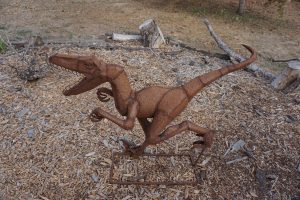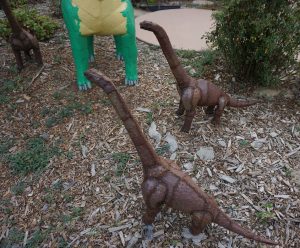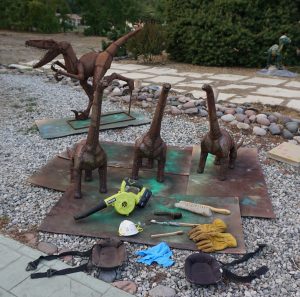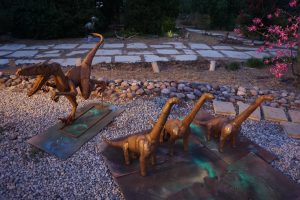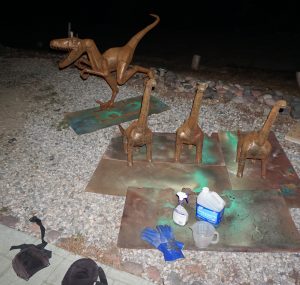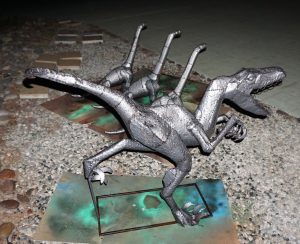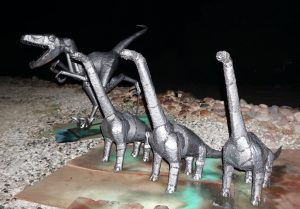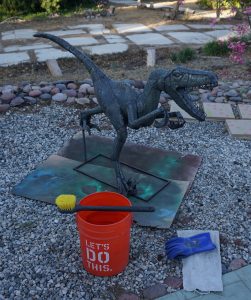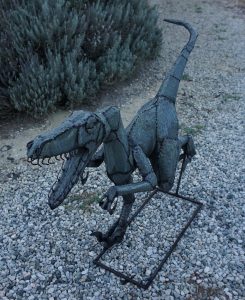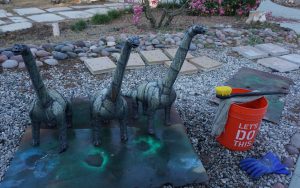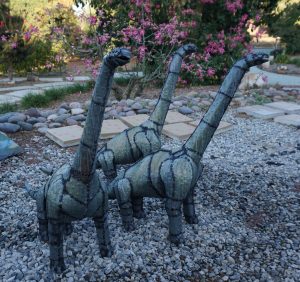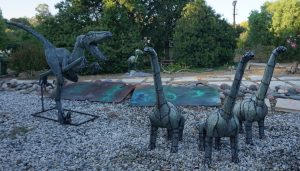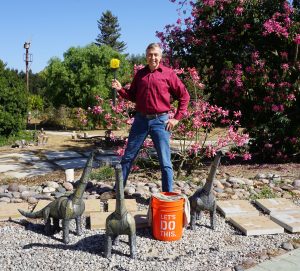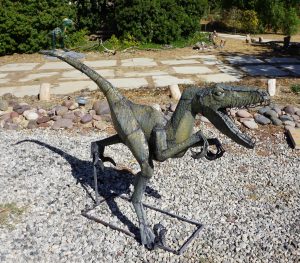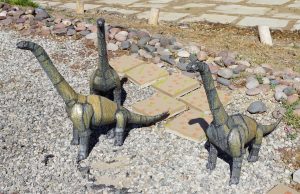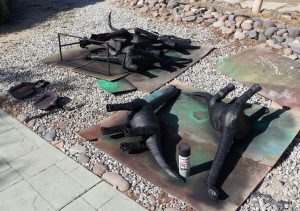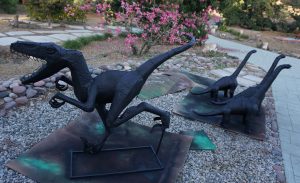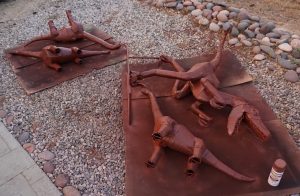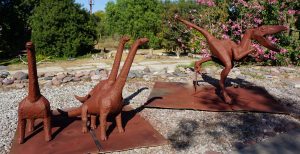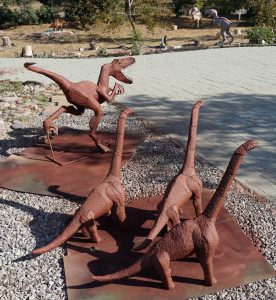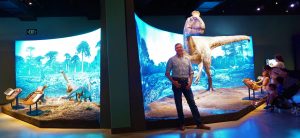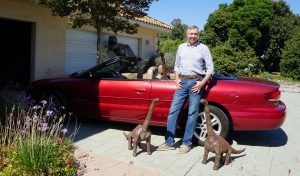The Newest Members of the Park are getting their makeovers. The Running Raptor, Blue Too, and the baby Brontosaurs – Arlo, Libby & Kristen are looking forward to rust removal & color splashes.
1st Step: Wire Brushing. Have the Proper Tools & Protection – Leather & Blue Nitrile Gloves, Various Sized Wire Brushes, Dusting Brush, Blower, Protective Clothing, Knee Pads, Hat & Eye Wear. I start with the Dinosaurs on their sides to clean the bottom frame, inside the legs and the tight spots underneath. The knee pads are helpful for this part of the process. Upright to finish, dusting brush and blower to clean area.
2nd Step: Acid Wash. Supplies needed Protective Clothing, Hat, Rubber Gloves & Eye Wear; Brushes; Spray bottle; Etching Acid; measuring cup or other container to transfer Etching material to spray bottle. Again, start with Dinosaurs on their side same reasons as above. Upright to finish. Remember to be very careful when spraying the etching acid. A gust of wind or quick change in its direction can blow the material back on You! Always make sure you keep the little ones and pets out of range, as well. The brushes help with getting the material into heavy rust areas. Let set over night.
3rd Step: Acid Rinse. Supplies needed Protective Clothing, Hat, Rubber Gloves & Eye Wear; Brushes; Towel, Bucket & Water. A damp towel is great for the final wipe down after brushing. Let Dry Completely.
4th Step: Rust Reformer. After You’re sure the Dinosaur is dry, spray on the Rust Reformer to provide a nice seal. Again, starting on their sides. After a couple hours upright to finish. You may like the flat black look and decide to clear coat at this step. Or maybe add a few details eyes, etc.… and then clear coat.
5th Step: Primer. I use the Rusty Brown Primer. I have used the white before too. If your base colors are very light you might consider the white primer. After a day or two for curing, it’s time for color.
The Thundering long-necked Sauropods are not only the largest animals to ever walk the earth but are unlike any animals in today’s World. Up to 115 feet long and 70 tons, no other herbivores have dominated the terrestrial ecosystem. And they ate vegetation by the ton! Can You imagine the sound of a herd of these enormous animals walking across the landscape? Below is link to Sauropod on Wikipedia. Check out the Cladogram by Sander and Colleagues from 2011. The Sauropods at that time had 37 branches in their Family Tree!
https://en.wikipedia.org/wiki/Sauropoda
Raptors of the family Dromaeosauridae per a Cladogram by Robert DePalma, David Burham, Larry Martin, Peter Larson and Robert Bakker in 2015 indicated 16 different members. These pack hunters from the 2.5-foot-long Microraptor to the Giant 23-foot-long Utahraptor weighing in at 1,100 lbs. were certainly a terror of their time.
https://en.wikipedia.org/wiki/Velociraptor
From Egg fossils that contained the unhatched Dinosaurs & Pterosaurs Scientists have discovered the babies would be fully developed at hatching to find food and fend for themselves and that baby Pterosaurs could fly as soon as they hatched.
For more information check out these Great Books:
“Dinosaurs” by Steve Brusatte
“The Rise and Fall of the Dinosaurs – A New History of a Lost World” by Steve Brusatte
“Pterosaurs” by Mark P. Witton
Stay Tuned for Splashes of Color to these Dinosaurs & More on David the T-Rex’s new Perch!
Be sure to check out “Titanosaurs 3D” & “Antarctic Dinosaurs” while You still can
At the Natural History Museum in Los Angeles!
“Encouraging the Appreciation of Art and Education through the Inspiration of Dinosaurs”
Paul & Prehistoric Pals
Your feedback is appreciated, Thank you
